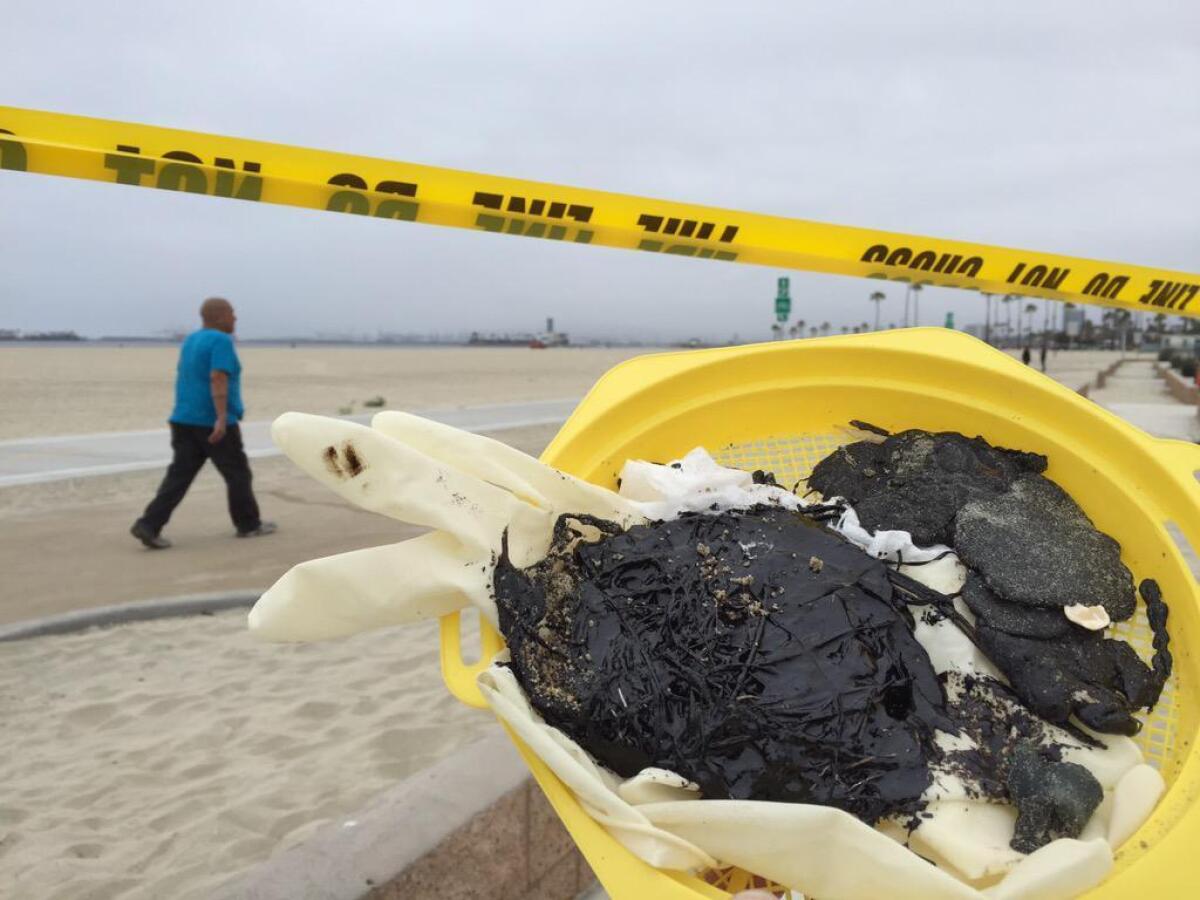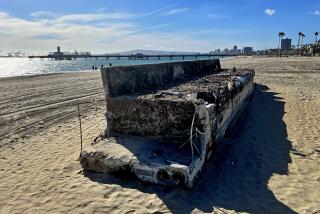What are the tar balls that are closing beaches in L.A. County?

Some tar balls found on the sand in Long Beach are shown.
Gooey black tar balls have been closing beaches in Long Beach and in the South Bay, showing up like a strange invasive species in recent days.
What are tar balls?
Tar balls are dark-colored, sticky blobs of oil that occur when crude oil floats on the ocean surface, changing its physical composition in a process called “weathering,” according to the National Oceanic and Atmospheric Administration.
After an oil spill or naturally-occurring seep, the oil spreads into a thin slick. Wind and waves break the slick up into small patches, or tar balls, that scatter into the ocean.
Initially, the lighter components of the oil evaporate or dissolve in the water, leaving behind the heavier types of oil, like crude, according to the state Department of Fish and Wildlife’s Office of Spill Prevention and Response. The crude then mixes with saltwater to create a thick, sticky substance.
Do tar balls on the beach mean there has been an oil spill?
Yes, that is often the case -- but not always.
New tar balls appearing on the beach, especially in large numbers, might indicate an industrial oil spill, according to the NOAA.
Tar balls can also occur naturally from fissures in the ocean floor, “places where oil just gurgles up,” said Alexia Retallack, a spokeswoman for the Department of Fish and Wildlife.
The spread of tar balls depends on a variety of factors, including storm surges and shifts in currents, Retallack said.
What do they look like?
Tar balls are generally coin-sized, but can be bigger, forming “tar patties” that are the size of pancakes, wildlife officials said.
They are often “hard and crusty on the outside, soft and gooey on the inside, like a toasted marshmallow,” according to the Department of Fish and Wildlife. Fresh tar balls can have the consistency of molasses. The hotter the air or water, the stickier the tar ball.
How far can tar balls travel?
Hundreds of miles. They are persistent in the marine environment, difficult to break down.
Are the tar balls appearing in Los Angeles County coming from the Santa Barbara oil spill?
In recent days, tar balls have washed ashore in Ventura County, Malibu and the South Bay, where a nearly eight-mile section of the beach was closed for three days last week. On Thursday morning, beaches between 1st Place and 72nd Place in Long Beach were closed because of tar balls.
The U.S. Coast Guard collected samples of the tar to determine their source. Laboratory testing will help investigators determine whether the tar traveled from Santa Barbara County, where a May 19 oil spill released as much as 101,000 gallons of crude, including about 21,000 gallons into the water.
Long Beach city officials said Thursday there was no indication they came from operations by the Long Beach Gas and Oil Department.
How are tar balls removed?
Officials can pick up the tar balls by hand or with beach-cleaning machinery. If the impact is severe, the top layer of sand might be removed and replaced with clean sand, according to the NOAA.
What should you do if you come into contact with a tar ball?
Officials say people should try to avoid contact with tar balls.
If you do come into contact with one, immediately wash the skin with soap and water, baby oil or other safe, widely used cleaning compounds that remove oil, according to the NOAA. Avoid using solvents, gasoline or kerosene on the skin, which are more dangerous than the tar ball itself.
Are tar balls harmful to your health?
For most people, brief contacts with tar balls or a small amount of oil are not harmful, but people who are particularly sensitive to chemicals and petroleum products might develop allergic reactions or a rash.
Limited exposure to crude oil for short periods of time is unlikely to cause long-term health effects, according to the Santa Barbara County Public Health Department.
What should you do if you see tar balls on the beach or wildlife covered in oil?
If you notice an unusual number of tar balls on the beach, call the U.S. Coast Guard at (800) 424-8802.
If you see wildlife covered in oil, do not try to clean it yourself. Call the Oil Wildlife Care Network at (877) 823-6926.
Twitter: @haileybranson | Google+
More to Read
Start your day right
Sign up for Essential California for news, features and recommendations from the L.A. Times and beyond in your inbox six days a week.
You may occasionally receive promotional content from the Los Angeles Times.






